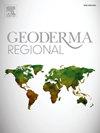草地生态系统中的土壤碳储量:土地管理、气候变化和土壤化学转化的作用
IF 3.3
2区 农林科学
Q2 SOIL SCIENCE
引用次数: 0
摘要
了解气候变化与土壤特征之间的复杂关系对于有效管理土壤有机碳储量至关重要。本研究对三种不同的土地管理类型(放牧地、未受干扰的牧场和耕地)的土壤特性进行了全面分析,包括依次提取成土氧化物和碳分馏。利用RothC模式,对三种不同气候情景(基线气候、暖干气候和冷湿气候)下63年的有机碳变化进行了预估。研究结果显示,每种管理实践中观察到的和模拟的SOC值之间存在很强的线性相关性。在不考虑气候变化的情况下,该模型预测农田土壤有机碳减少4.21%,放牧地减少2.37%,而未受干扰的牧场土壤有机碳增加3.04%。在暖干情景下,所有样地的有机碳含量均呈下降趋势,而在冷湿情景下,所有样地的有机碳含量均呈上升趋势。与耕地和放牧地相比,未受干扰的牧场由于长期暴露于风化作用而表现出独特的特征。这些变化包括蚀变化学指数的显著增加,微团聚体组分中遮挡碳含量的增加,以及亚硫土和草酸盐可提取的铝和铁含量的变化。这些因素增强了有机碳对微生物分解的物理保护。土壤有机碳与这些因子以及腐殖化有机质库呈显著正相关。综上所述,了解管理实践、气候条件和有机碳保护机制之间的关系对明智的决策至关重要。本文章由计算机程序翻译,如有差异,请以英文原文为准。

Soil carbon storage in rangeland ecosystems: The role of land management, climate change, and soil chemical transformations
Comprehension of the complex relationship between climate variations and soil characteristics is crucial for effectively managing soil organic carbon stocks (SOCs). This study involved a comprehensive analysis of soil properties, including sequential extraction of pedogenic oxides and carbon fractionation, across three distinct land management types: grazing land, undisturbed rangeland, and cultivated rangeland (cropland). Using the RothC model, projections were made to assess changes in SOC over a 63-year period under three different climate scenarios: baseline climate, warm-dry, and cool-wet scenarios. The findings revealed a strong linear correlation between observed and modeled SOC values for each management practice. Without climate change, the model predicted a 4.21 % decrease in SOC for cropland and a 2.37 % decrease for grazing land, while undisturbed rangeland showed a 3.04 % increase. Under the warm-dry scenario, all sites experienced a decline in SOC, whereas under the cool-wet scenario, SOC increased uniformly across all sites. In contradistinction to cropland and grazing land, undisturbed rangeland exhibited unique characteristics due to its long-term exposure to weathering. These included a significant increase in the chemical index of alteration, higher levels of occluding carbon within the microaggregates fraction, and varied amounts of dithionite and oxalate-extractable aluminum and iron. These factors enhanced the physical protection of SOC from microbial decomposition. This was supported by positive correlations between SOC and these factors, as well as the humified organic matter pool. In summary, understanding the relationship between management practices, climatic conditions, and the mechanisms that govern SOC conservation is pivotal for judicious decision-making.
求助全文
通过发布文献求助,成功后即可免费获取论文全文。
去求助
来源期刊

Geoderma Regional
Agricultural and Biological Sciences-Soil Science
CiteScore
6.10
自引率
7.30%
发文量
122
审稿时长
76 days
期刊介绍:
Global issues require studies and solutions on national and regional levels. Geoderma Regional focuses on studies that increase understanding and advance our scientific knowledge of soils in all regions of the world. The journal embraces every aspect of soil science and welcomes reviews of regional progress.
 求助内容:
求助内容: 应助结果提醒方式:
应助结果提醒方式:


